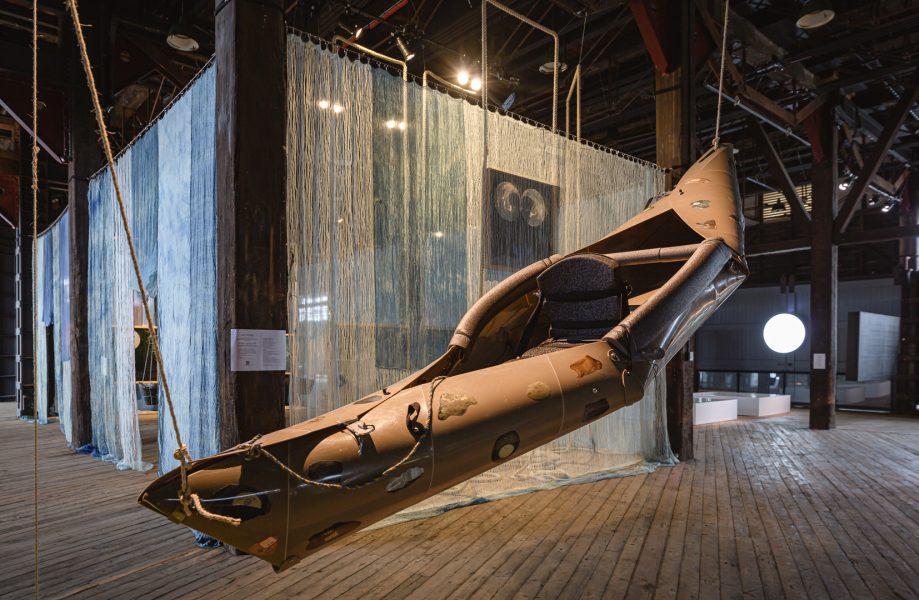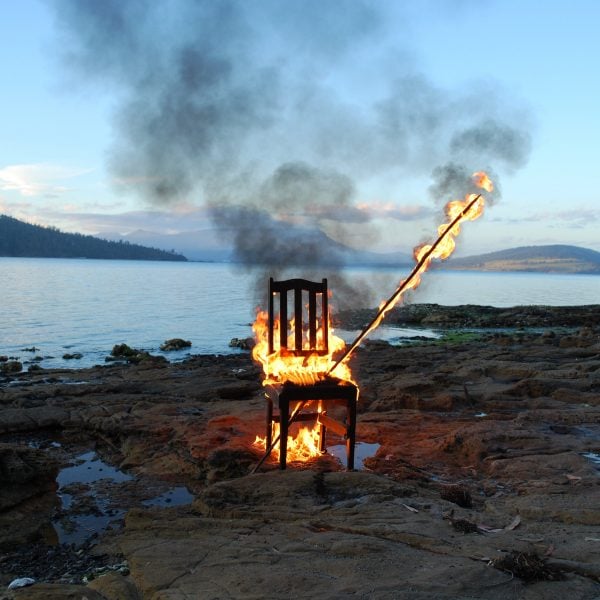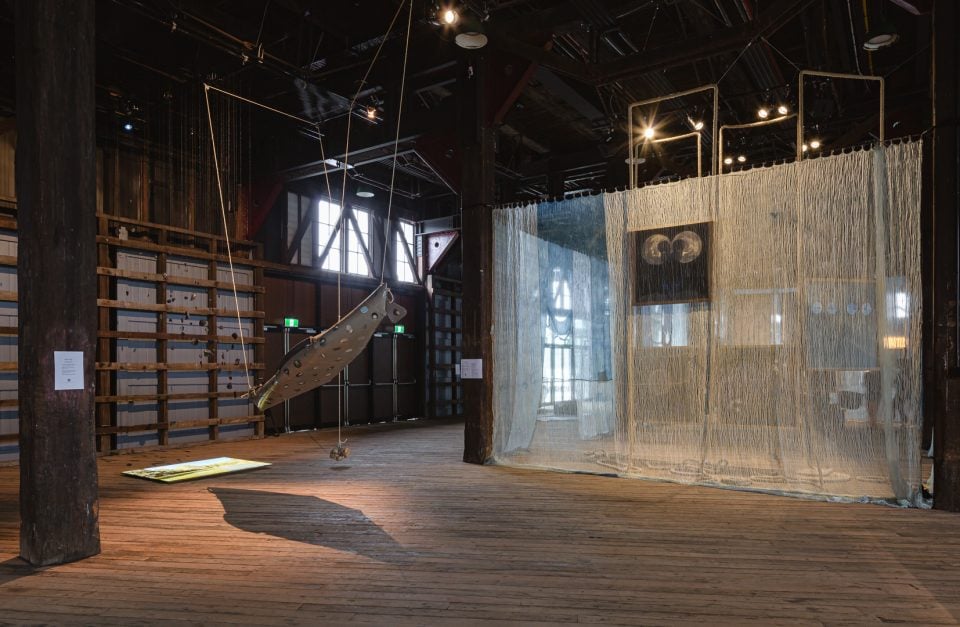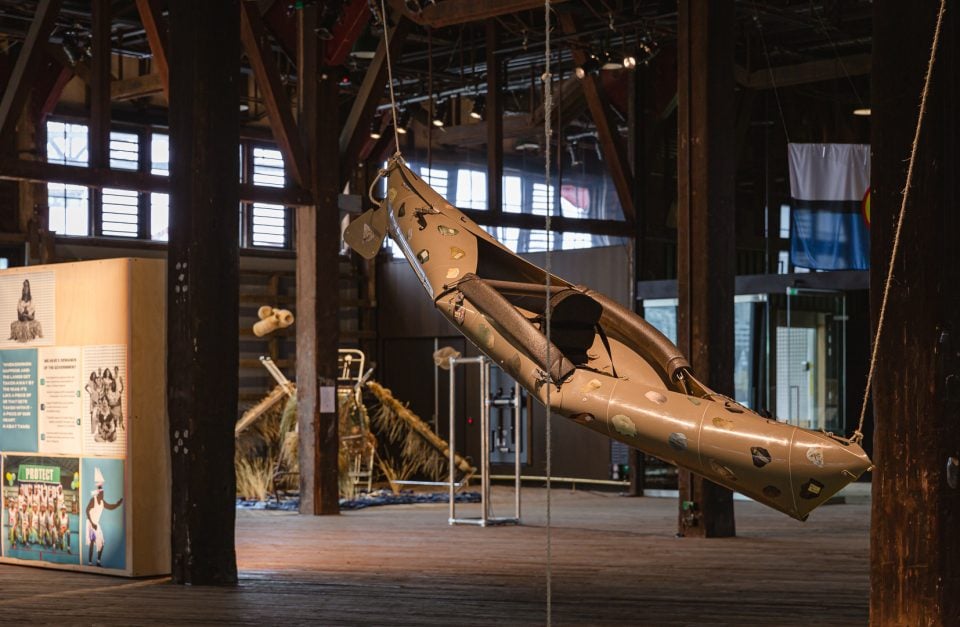p/re-occupied, 2022
mixed media, video projection, sound, kayak, rocks (Paranaple river, Lutruwita / Tasmania), edited by Craige Langworthy
7:23 mins
Courtesy the artist. This project has been realised in accordance with ICIP protocols (visual arts), (Janke, 2019, Australia Council) and acknowledges the custodial interest of the First Peoples of Lutruwita (Tasmania) on whose unceded lands, riverways and estuaries this work was realised.
Commissioned by the Biennale of Sydney with generous assistance from Arts Tasmania and the Australian Museum
Trawlwoolway artist Julie Gough follows several interconnecting ancestral rivers and tributaries in the Midlands of Tasmania and the absence of ancestral objects for the 23 Biennale of Sydney. Gough has 3D printed up to 100 Tasmanian stone tools held in the Australian Museum collections off-Country suspended like a shower of black rain. Footage of Gough kayaking along isolated waterways of paranaple (Mersey river), panatana creek, tinamirakuna (Macquarie river) and lokenermenanya (Clyde river) is a virtual return to Country and Riverways for the tools. The sack of river rocks collected from paranaple (Mersey river) balance the vessel Gough used to visit these sites of un/return. The stickers of Tasmanian tools are like disturbing avatars and we are left to imagine the possibilities if only the artist was in possession of the tools. Gough is uncovering the glitches in using new technologies to repatriate facsimiles of cultural belongings. Through the distance of covid lockdowns Gough never got to hold these stone tools handmade by her Old People.
Julie Gough says ‘In boxes in state museums our Country lays by the ton. Our Ancestors’ stone tools were taken, shipped offshore. Their absence wilfully erases evidence of the longest occupation of any place by a people. How can a culture of colonists arrive, new and blind, and believe they can own the living land, its waterways, its creatures, and therefore control time, the future?’
Absorption
The waterways of Lutruwita
(Tasmania) flow, they absorb
and carry and redistribute.
They swell and break their
banks. They dry and capture
at their edges imprints of birds
and wallabies, cows and sheep,
kayakers and anglers. The
original names of these arteries
of Country are little known and
hardly spoken. Some are lost in
time. —Julie Gough, 2021
These waters await new names in First language by their Aboriginal
people, words that respect their past and purpose and alliterate their
flow since invasion, since colonisation. Survivors. Kin. They guided
my Ancestors who walked alongside and waded their depths. These
rivers and creeks, estuaries and lagoons have absorbed so very much
of our blood, our stories, ourselves. They hold our past yet helped
erase our presence, our pre-occupation of this place before the British
planted their flag in 1803. We were dispersed, killed, reduced to ash by
colonists, then flushed like so much detritus through the river systems
that once sustained us. Every story of us, my Ancestors, is held,
absorbed by waterways that have been tortured ever since, controlled,
condemned to serve.
To be home truly, on Country, is to become it. Particles. Substance
of place. Belonging. Inhale. Exhale. Everything seems to swirl around,
to gather, reform, then set out again. Like murmuring birds everything
attempts to test and reset, in order to work properly, know its place,
align to synchronise. And yet, on walls in state galleries are lauded
colonial renditions of such places where my forebears were killed
or from which they were banished. These don’t carry Aboriginal
placenames and rarely show the original people, because these artwork
landscapes claim place much like land title deeds, then fabricated and
since inherited.
In boxes in state museums our Country lays by the ton. Our
Ancestors’ stone tools were taken, shipped offshore. Their absence
wilfully erases evidence of the longest occupation of any place by
a people. How can a culture of colonists arrive, new and blind, and
believe they can own the living land, its waterways, its creatures, and
therefore control time, the future? How can original people wake them
up without sacrificing too much to the task? When I kneel by a river
on my island home, I don’t need to see my reflection to be grounded.
Our Old People are in the wind, my imprint in that mud is the same
repeated, over millennia, by family.




